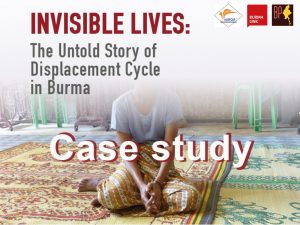Fleeing Sexual Violence from Yebyu Township to the Thailand-Burma Border: Mon IDP Report Case Study #1
By Burma Link, Burma Partnership and Human Rights Foundation of Monland • September 7, 2016
The following case study is from the joint report “Invisible Lives: The Untold Story of Displacement Cycle in Burma” by Human Rights Foundation of Monland (HURFOM), Burma Link, and Burma Partnership, which was launched in a press conference in Rangoon on August 12th and in Moulmein on August 15th. The 65-page report focuses on the continuing concerns of the displaced ethnic nationality communities, particularly the ethnic Mon, living along Burma’s southeast border and finds that the recent reforms have not yet addressed the causes of their displacement.
Download the full report in English here.
အစီရင္ခံစာ ျမန္မာဘာသာကုိ ဤေနရာတြင္ ရယူႏုိင္သည္။
The following is the first case study in a series that HURFOM, Burma Link and Burma Partnership will be publishing in the coming weeks along with a series of selected interviews. The series is meant to give more in depth understanding into the situation of Mon IDPs and villagers. See methodology in the report.
Fleeing Sexual Violence from Yebyu Township to the Thailand-Burma Border1: Case Study 1
Mi Sanda Si Aye’s2 mother passed away when she was 18 years old. As the eldest sibling, she took on the role of a mother for her younger siblings. Their father was a fisherman who was often away at sea, and Mi Sanda Si Aye struggled to put food on the table while trying to protect herself and the family from the harassment they often received from the Burma Army.
“I remembered what my aunt had told me; to carry my youngest brother, so they would think I’m a mother with a baby,” Mi Sanda Si Aye says as she recalls one of the times that the Burma Army soldiers came to her house. Her aunt had always reminded her to carry her youngest brother as the soldiers were less likely to take her away to rape her if she was carrying a baby. The houses were far away from each other, and a cry for help would not have been heard between the living quarters. Any time the Burma Army soldiers arrived to her village, men would run and hide to escape forced portering duties that would sometimes last for months. When the men were away, women stayed in the village, becoming easy prey for the soldiers. To protect themselves, the village women slept under the same roof in groups; “If something happened to one of us, the rest of us could scream for help,” Mi Sanda Si Aye explained. The soldiers often returned for information regarding Mon soldiers, leading to threats and interrogation of the villagers. Mi Sanda Si Aye’s cousin once visited a friend in a neighboring village, and upon his arrival, was interrogated, tortured, and finally beaten to death.
When Mi Sanda Si Aye was 19-years-old, she decided to leave the village and take her younger siblings to a safer place. They followed their aunts and walked across the jungle to the Thailand-Burma border. Mi Sanda Si Aye and her family stayed in a refugee camp in Thailand until they were forced to move back to Burma in 1995. Along with thousands of others, Mi Sanda Si Aye moved to Halockhani IDP site where she has lived for over 20 years. Due to difficulties in making ends meet, her husband is now working in Thailand and sending money to her and their three children. Although she hasn’t faced abuse for decades, Mi Sanda Si Aye says she is still afraid of the Burma Army soldiers because of her experience from the past.
Tags: Burma Link, Burma Partnership, Displacement, Human Rights Foundation of Monland, IDPs and Refugees, Mon IDPsThe soldiers tried to take a girl and a mother would pull and grab her daughter tight. By the mother’s scream asking for help, the soldiers didn’t get her daughter. When I saw and heard this kind of story several times, I didn’t dare to live in the village anymore.
(Mi Sanda Si Aye)
This post is in: Children and Youth, Displacement, Ethnic Nationalities, Health, Human Rights, Military Regime, Women
Related PostsAnn Din Coal Power Plant: Local Movement and Action to Preserve and Protect Natural Resources and Land: Mon IDP Report Case Study #4
Burma Army Continues to Act with Impunity1: Case Study #3
Landmine Victim in Jo Haprao, Bee Ree: Mon IDP Report Case Study #2
New Report Urges Government to Address Protracted Displacement in Upcoming Panglong Conference
လူူမသိသူမသိဘ၀မ်ား – ျမန္မာႏိုင္ငံမွ လူမသိေသးေသာေနရပ္စြန္႔ခြာတိမ္းေရွာင္ရမႈ သံသရာ









 All posts
All posts